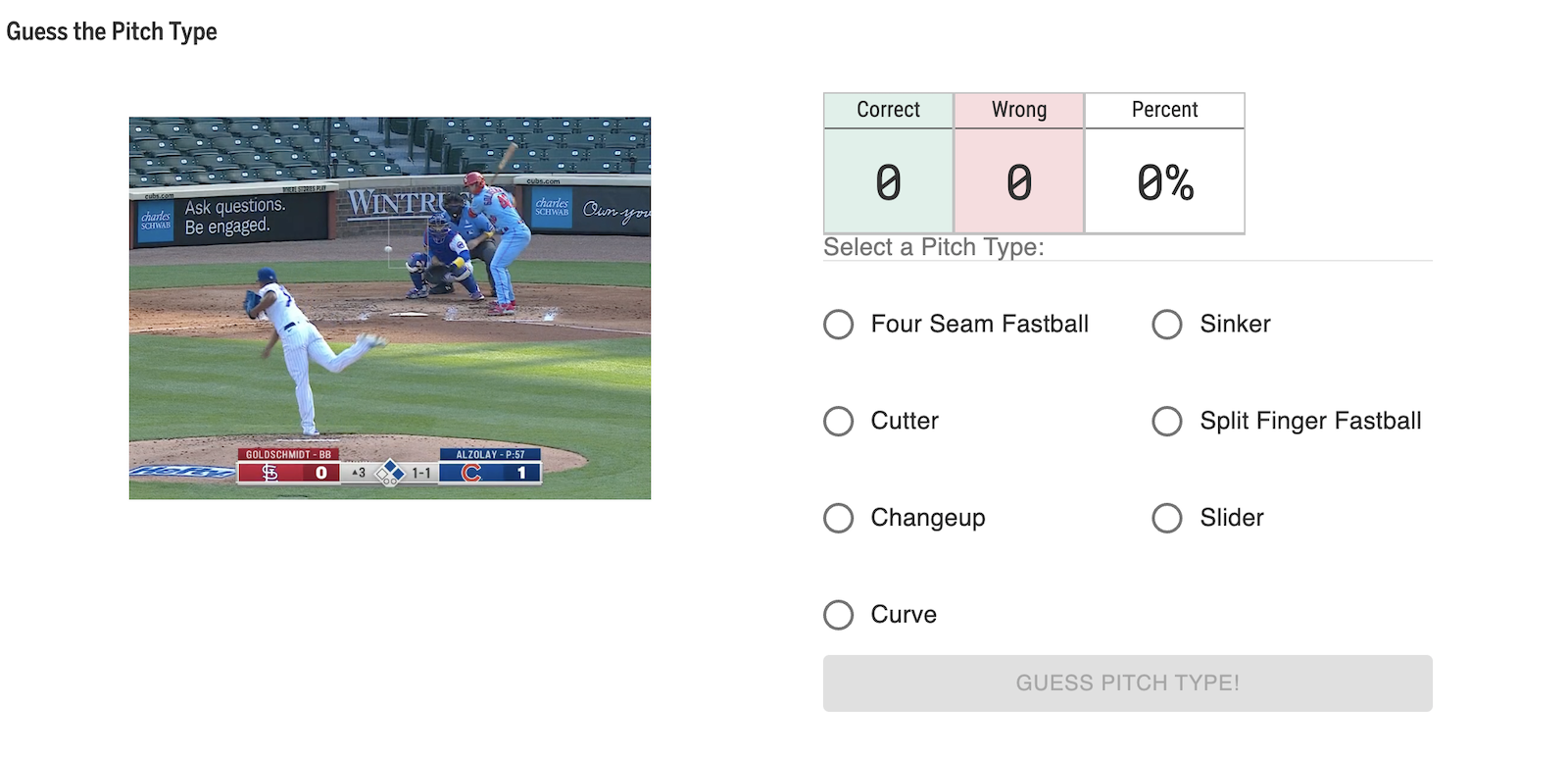By God, I Will Get A Good Grade On Statcast’s Pitch Type Guessing Game
2:41 PM EDT on May 19, 2022

Everyone, at some point in their life, should get their ass kicked by the Pitch Type Guessing Game up on Baseball Savant. It builds character. After playing upwards of 100 times, to the point where I no longer remember how to navigate to the game from the front page because it's the third suggested site when I type "b" into the search bar behind only baseballsavant.com and baseball-reference.com, I can confidently say that I am very normal about Statcast specifically and baseball in general.
I can also say that while I have gotten pretty good at guessing pitch types, to the point where I average around a 70 percent score (passing!) and once peaked at 90 percent on one of the best days of my life (doubly impressive considering that I have the approximate depth perception of a one-eyed cow), some pitches are absolute bullshit.
Pitches reject quantization. You can usually group them by movement, but there are always exceptions. Tyler Glasnow, may his UCL heal speedily, calls his non-curve breaking ball a "slutter" as in a slider/cutter cross, though Statcast categorizes it as a slider. Who knows what the hell Chris Sale is even throwing, but let's just call it a slider. Young Canadian Matt Brash on the Mariners, may he return soon from the minors, has two slightly different breaking balls with wild movement, one of them a slider and the other a knuckle curve, or you can call them both sliders. You get the drill.
Everything that translates from a pitcher trying to con a batter also translates through video—throwing side-arm or submarine-style, daring to be a lefty—while undergoing additional levels of in-game distortion as the camera changes angle depending on broadcast, eats up left-handed pitch movement if you have poor depth perception, and occasionally shows a dude being interviewed for most of the pitch before switching back just in time to glimpse the ball entering the catcher's mitt.
Some information is constant: pitch speed, pitch location, etc. But without knowing the pitcher's repertoire, the variety of different pitch profiles across the league renders creating a firm set of characteristics a futile task. A curveball can have straight 12-to-6 drop, or it can have some horizontal movement, like a slider. A four-seamer is a straight, occasionally rising fastball if you're a spin warrior, unless it happens to have lateral run—shout out to Brusdar Graterol. A four-seamer can range anywhere from 88-105 mph. On the other hand, some people throw changeups at 88 mph or, in the extreme case of Gerrit Cole freakery last season, throw a 95-mph change immediately following a 102-mph fastball.
“Was that a 95 MPH changeup?”
— Dan Rourke (@DanAlanRourke) June 17, 2021
“Ya” - Gerrit Cole
“How?” - @lindseyadler LOL pic.twitter.com/L2wmc7xFIp
None of this is novel information, but it takes on a new light when you try to label pitch types yourself. I took the liberty of playing a few rounds of pitch-guessing on company time and recording my results, and I didn't even interfere with the scientific process by fudging over the two (2) times I called a left-handed four-seam fastball a slider. Other common mistakes: mistaking a four-seamer for a sinker, mistaking a sinker for a four-seamer, and mistaking any breaking pitch for a slider. If a left-hander was throwing a pitch in the high-80s, I was literally just guessing. It's a humbling experience, looking like I might finally get 100 percent until a lefty waltzes up and tanks my score. (You can find the full results here, if you're curious for some godforsaken reason.)
For all the justifiably pervasive fear surrounding how numbers have solved baseball, singlehandedly killing the stolen base or limiting offense through defensive positional adjustments or boiling players down to individual statistics to better assign their value in arbitration, there will always be something interesting or inexplicable to mine from pitching. Of course, playing a Statcast game where you try to guess pitch types from recorded video doesn't translate to trying to recognize a pitch in the batter's box anymore than being in the passenger seat of a car driving down the New Jersey Turnpike qualifies you for driving a Formula One car. But it does convey the futility of the experience quite well.
The takeaway here is that I cannot recommend being a freak about guessing pitch types enough. It's comforting, knowing that no matter the general state of MLB, pitchers will find ways to be stupidly good. Sometimes via cheating, even! Forget the limits of human knowledge or capability; some person out there will always do something that will allow everyone to get freakier—discovering the accelerating expansion of the universe, employing seam-shifted wake, left-handed pitchers, the like.
If you liked this blog, please share it! Your referrals help Defector reach new readers, and those new readers always get a few free blogs before encountering our paywall.
Staff Writer
Read More:
Stay in touch
Sign up for our free newsletter




